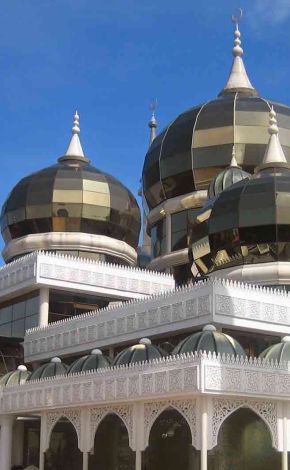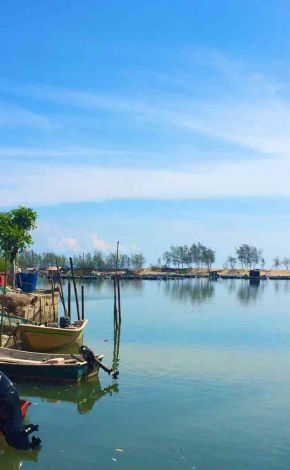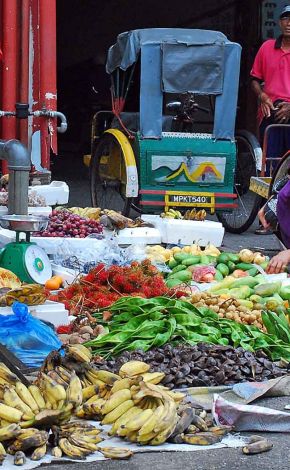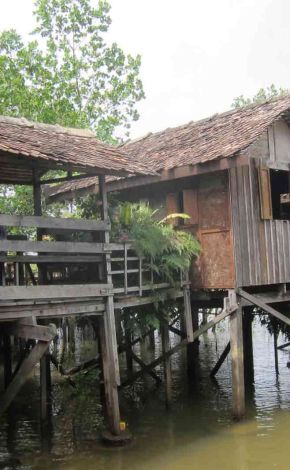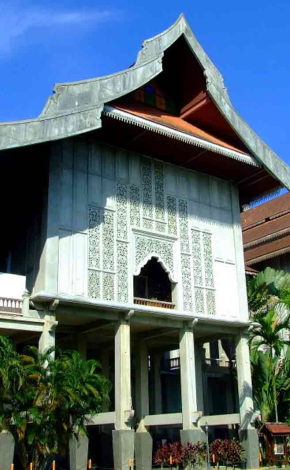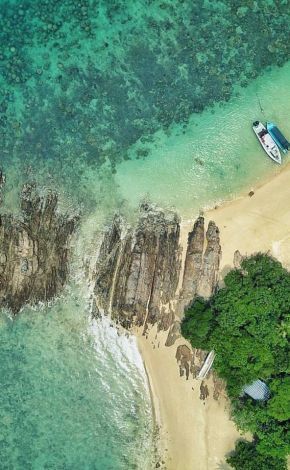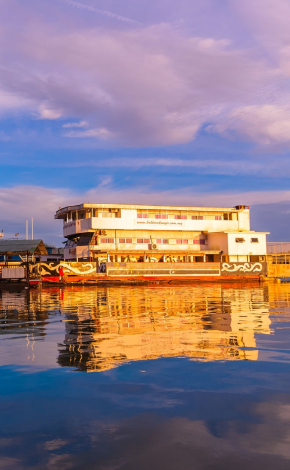Uniqueness of this attraction
Uniqueness of this attraction
The Chinatown in Kuala Terengganu is unique as it is said to be one of the earliest recorded places where Chinese traders have settled in Malaysia. There are many ancestral homes here along with clan townhouses. Buildings here were also built traditionally to resemble buildings from the settlers place of origin in China. This led to the Chinatown area being awarded heritage status by the United Nations UNESCO World Monument Watch Programme.
You’ll find many Chinese temples here, along with food courts, kopitiams (local coffee shops) and small businesses. The culture in Chinatown is also a special one as the mixture of Malay and Chinese cultures gave rise to a small Peranakan group called Mek and Awang that retains its differences from other Peranakan cultures in Malaysia.
As part of a restoration and beautification programme, back alleys that connect all these shophouses together are also being cleaned and reformed as tourist spots. About seven laneways have been filled with murals and street art, each with it’s own unique design and theme. With a variety of attractions and photography opportunities, it’s definitely a part of Chinatown you wouldn't want to miss exploring!
You’ll find many Chinese temples here, along with food courts, kopitiams (local coffee shops) and small businesses. The culture in Chinatown is also a special one as the mixture of Malay and Chinese cultures gave rise to a small Peranakan group called Mek and Awang that retains its differences from other Peranakan cultures in Malaysia.
As part of a restoration and beautification programme, back alleys that connect all these shophouses together are also being cleaned and reformed as tourist spots. About seven laneways have been filled with murals and street art, each with it’s own unique design and theme. With a variety of attractions and photography opportunities, it’s definitely a part of Chinatown you wouldn't want to miss exploring!
Other things to do here?
Other things to do here?
Just a stone’s throw away from the main Chinatown area, you can visit Pasar Payang. It’s right by the Terengganu river and is one of the city’s most famous tourist attractions. Being a covered open air market, you don’t have to worry about the weather while shopping for cheap local fruits or traditional handicrafts such as batik sarongs.
If shopping isn’t your cup of tea, take a boat for a few ringgit from one of the local markets to Pulau Duyong. Here you can stay at Awi’s Yellow House for a night and see how life was like in the olden days at a traditional Malay fishing village.
If shopping isn’t your cup of tea, take a boat for a few ringgit from one of the local markets to Pulau Duyong. Here you can stay at Awi’s Yellow House for a night and see how life was like in the olden days at a traditional Malay fishing village.
What to bring home?
What to bring home?
Chinatown here is a gold mine for quality souvenir items specifically those relating to turtles. Chinatown also has well known mini butter buns (roti paun) from T Homemade Cafe (or any kopitiam really) which you can pack to bring home. Don’t forget your to capture the traditional architecture of Negeri Sembilan and art murals along the little alleys to keep as memories.
Who should I travel with?
Who should I travel with?
Solo , Couple , Friends , Family , Group
Getting around
Getting around
You can always use a taxi cab to get from anywhere in Kuala Terengganu to Chinatown.An easier alternative is to use Kuala Terengganu’s Bas Bandar service. The buses are unique and unmistakeable as they are designed to look like a traditional Malay house. There’s a RM 1 flat fee for you to go to any destination along the bus’s route. Stop at the Hentian Bas Majlis Bandaraya Kuala Terengganu bus stop. From here it’s only an 8-minute walk to Chinatown.
Insiders’ tips
Insiders’ tips
- Always negotiate your price with the taxi driver before getting into the taxi cab!
- Negotiate if you want to buy something from the stalls or markets! In certain cases you can get up to a third of the price slashed off.
- Check out where the locals are huddled at for the best guess of a good place to get a meal. Even better, engage in conversation with a local and ask around!
- It’s very lively during the weeks leading up to Chinese New Year so do plan ahead and make your bookings early if you want to witness the celebration.
- Most restaurants only open in the evening for dinner service. Lunchtime and breakfast options are limited to the kopitiams, food courts and smaller cafes.
- It is best to come here during the evening, around 5pm onwards so you get to walk and enjoy the market as well as various street food offered.
Established since the 16th century, Chinatown in Kuala Terengganu is a mix of colorful shophouses, temples, delicious food and eye catching street art.
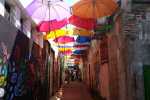
Opening hours
Always open
Established since the 16th century, Chinatown in Kuala Terengganu is a mix of colorful shophouses, temples, delicious food and eye catching street art.

Opening hours
Always open
Uniqueness of this attraction
Uniqueness of this attraction
The Chinatown in Kuala Terengganu is unique as it is said to be one of the earliest recorded places where Chinese traders have settled in Malaysia. There are many ancestral homes here along with clan townhouses. Buildings here were also built traditionally to resemble buildings from the settlers place of origin in China. This led to the Chinatown area being awarded heritage status by the United Nations UNESCO World Monument Watch Programme.
You’ll find many Chinese temples here, along with food courts, kopitiams (local coffee shops) and small businesses. The culture in Chinatown is also a special one as the mixture of Malay and Chinese cultures gave rise to a small Peranakan group called Mek and Awang that retains its differences from other Peranakan cultures in Malaysia.
As part of a restoration and beautification programme, back alleys that connect all these shophouses together are also being cleaned and reformed as tourist spots. About seven laneways have been filled with murals and street art, each with it’s own unique design and theme. With a variety of attractions and photography opportunities, it’s definitely a part of Chinatown you wouldn't want to miss exploring!
You’ll find many Chinese temples here, along with food courts, kopitiams (local coffee shops) and small businesses. The culture in Chinatown is also a special one as the mixture of Malay and Chinese cultures gave rise to a small Peranakan group called Mek and Awang that retains its differences from other Peranakan cultures in Malaysia.
As part of a restoration and beautification programme, back alleys that connect all these shophouses together are also being cleaned and reformed as tourist spots. About seven laneways have been filled with murals and street art, each with it’s own unique design and theme. With a variety of attractions and photography opportunities, it’s definitely a part of Chinatown you wouldn't want to miss exploring!
Other things to do here?
Other things to do here?
Just a stone’s throw away from the main Chinatown area, you can visit Pasar Payang. It’s right by the Terengganu river and is one of the city’s most famous tourist attractions. Being a covered open air market, you don’t have to worry about the weather while shopping for cheap local fruits or traditional handicrafts such as batik sarongs.
If shopping isn’t your cup of tea, take a boat for a few ringgit from one of the local markets to Pulau Duyong. Here you can stay at Awi’s Yellow House for a night and see how life was like in the olden days at a traditional Malay fishing village.
If shopping isn’t your cup of tea, take a boat for a few ringgit from one of the local markets to Pulau Duyong. Here you can stay at Awi’s Yellow House for a night and see how life was like in the olden days at a traditional Malay fishing village.
What to bring home?
What to bring home?
Chinatown here is a gold mine for quality souvenir items specifically those relating to turtles. Chinatown also has well known mini butter buns (roti paun) from T Homemade Cafe (or any kopitiam really) which you can pack to bring home. Don’t forget your to capture the traditional architecture of Negeri Sembilan and art murals along the little alleys to keep as memories.
Who should I travel with?
Who should I travel with?
Solo , Couple , Friends , Family , Group
Getting around
Getting around
You can always use a taxi cab to get from anywhere in Kuala Terengganu to Chinatown.An easier alternative is to use Kuala Terengganu’s Bas Bandar service. The buses are unique and unmistakeable as they are designed to look like a traditional Malay house. There’s a RM 1 flat fee for you to go to any destination along the bus’s route. Stop at the Hentian Bas Majlis Bandaraya Kuala Terengganu bus stop. From here it’s only an 8-minute walk to Chinatown.
Insiders’ tips
Insiders’ tips
- Always negotiate your price with the taxi driver before getting into the taxi cab!
- Negotiate if you want to buy something from the stalls or markets! In certain cases you can get up to a third of the price slashed off.
- Check out where the locals are huddled at for the best guess of a good place to get a meal. Even better, engage in conversation with a local and ask around!
- It’s very lively during the weeks leading up to Chinese New Year so do plan ahead and make your bookings early if you want to witness the celebration.
- Most restaurants only open in the evening for dinner service. Lunchtime and breakfast options are limited to the kopitiams, food courts and smaller cafes.
- It is best to come here during the evening, around 5pm onwards so you get to walk and enjoy the market as well as various street food offered.
